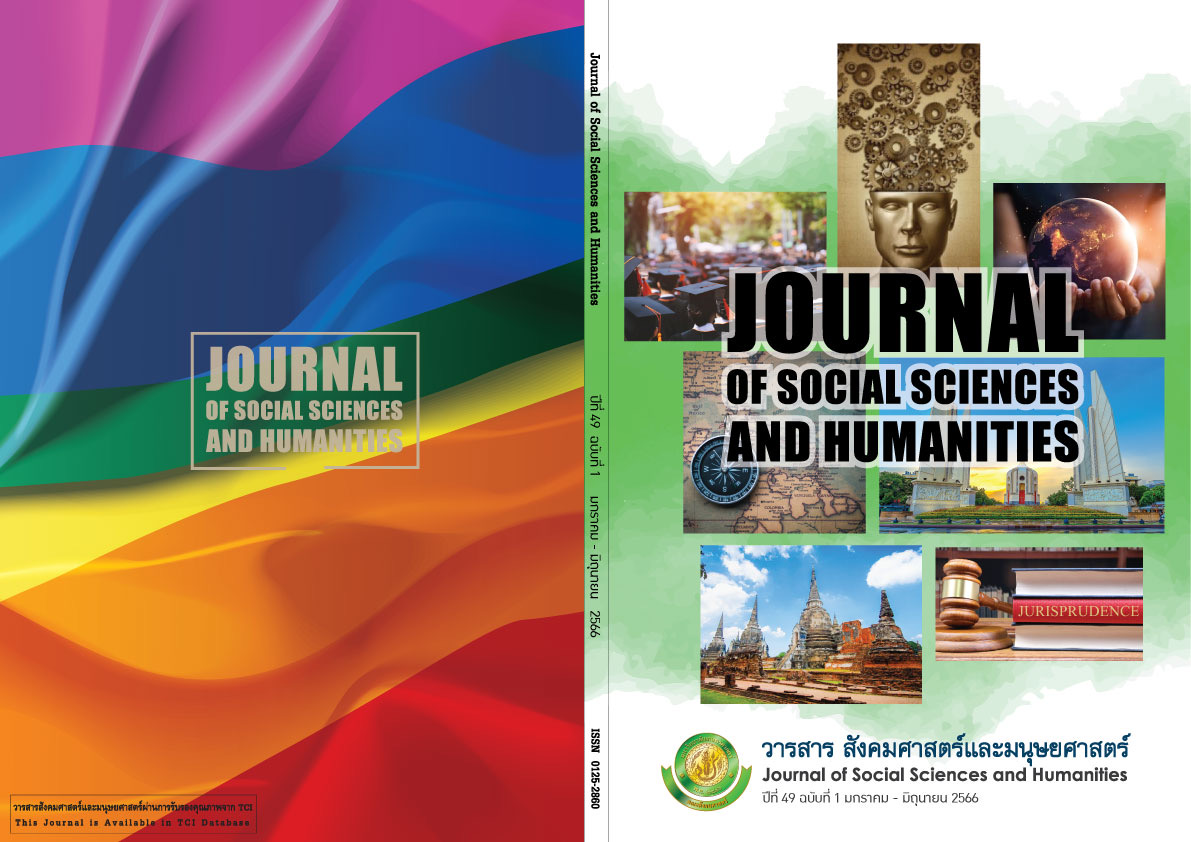จากนโยบาย “ลูกคนเดียว” สู่ “ลูกสามคน” บทวิเคราะห์ความท้าทายของนโยบายควบคุมประชากรในจีนสมัยใหม่
Main Article Content
บทคัดย่อ
ตั้งแต่การก่อตั้งสาธารณรัฐประชาชนจีนในปี 1949 เหมา เจ๋อตงสนับสนุนให้จีนมีประชากรจำนวนมาก เพราะเป็นทรัพยากรที่เป็นประโยชน์ในการพัฒนาทางเศรษฐกิจได้อย่างรวดเร็ว แต่จำนวนประชากรที่เพิ่มขึ้นอย่างก้าวกระโดดในทศวรรษที่ 1970 สร้างความกังวลให้แก่เติ้ง เสี่ยวผิงผู้นำจีนรุ่นที่ 2 เป็นอย่างมาก เขาจึงประกาศใช้ “นโยบายลูกคนเดียว” ทั่วประเทศในปี 1979
ตลอด 35 ปี นโยบายลูกคนเดียวได้สร้างความเปลี่ยนแปลงต่อโครงสร้างประชากร ความเชื่อ สังคม และเศรษฐกิจ ในสังคมจีนไปอย่างสิ้นเชิง บทความชิ้นนี้ต้องการอภิปรายนโยบายลูกคนเดียว ผลของนโยบายดังกล่าว การประกาศใช้ “นโยบายลูกสองคน” และ “นโยบายลูกสามคน” ของรัฐบาลจีน ผู้เขียนวิเคราะห์ความท้าทายของนโยบายดังกล่าวซึ่งที่มีท่าทีที่จะไม่ประสบความสำเร็จอันเป็นผลจากสถานะของผู้หญิงในสังคมจีน ค่านิยมในสังคมจีนที่เปลี่ยนไป สถานะทางเศรษฐกิจ และการเข้าถึงบริการทางการแพทย์ และโรคระบาด
Article Details

อนุญาตภายใต้เงื่อนไข Creative Commons Attribution-NonCommercial-NoDerivatives 4.0 International License.
เอกสารอ้างอิง
เฮาเวิรด์ จาง. (2022). นโยบาย “โควิดเป็นศูนย”์ ของจีน เพื่อคุมโรคหรือการเมือง. BBC News Thai.
https://www.bbc.com/thai/international-61304419.
ภากร กัทชลี. (2565). ความพยายามของ “จีน” ปลุกความมั่นใจ กระตุ้นคนรุ่นใหม่ให้ “อยากมีลูก.” กรุงเทพธุรกิจออนไลน์. https://www.bangkokbiznews.com/columnist/989553.
Alpermann, B., & Zhan, S. (2019). Population Planning after the One-Child Policy: Shifting Modes of Political Steering in China. Journal of Contemporary China, 28(117), 348-366.
https://doi.org/10.1080/10670564.2018.1542218.
Bloomberg. (2020). China’s Two-Child Policy. Bloomberg. https://www.bloomberg.com/
quicktake/china-s-two-child-policy.
Butt, K., & Sajid, S. (2018). Chinese Economy under Mao Zedong and Deng Xiaoping. Journal
of Political Studies, 25(1), 169-178.
Cai, Y., & Feng, W. (2021). The Social and Sociological Consequences of China’s One-Child Policy. Annual Review of Sociology, 47(1), 587-606. https://doi.org/10.1146/annurev-soc-090220-
Cao, W. (2015). Exploring ‘Glorious Motherhood’ in Chinese Abortion Law and Policy. Feminist
Legal Studies, 23(3), 295-318.
https://doi.org/10.1007/s10691-015-9291-7.
Chang, R. (2022). How “Leftover” Men In China Challenge Heteronormativity. (PhD dissertation).
College of Arts and Science, University of Kentucky. https://uknowledge.uky.edu/
gws_etds/8.
Chen, Y. (2022). Reflections on the Three-child Policy from the Perspective of Feminist Jurisprudence.805-808.
https://doi.org/10.2991/assehr.k.220105.147.
Chu, K., Zhu, R., Zhang, Y., Pang, W., Feng, X., Wang, X., … Li, W. (2022). Fertility Intention
Among Chinese Reproductive Couples During the COVID-19 Outbreak: A Cross-Sectional
Study. Frontiers in Public Health, 10, 1-9.
Currier, C. L. (2008). Investing in the Future: The One Child Policy and Reform. Journal of Women,
Politics & Policy, 29(3), 365–393. https://doi.org/10.1080/15544770802206077.
Deutsche Welle. (2021). 鼓励生、 限制生、 催着生! 中国生育政策的变迁. https://www.dw.com/
zh/%E9%BC%93%E5%8A%B1%E7%94%9F-%E9%99%90%E5%88%B6%E7%
%9F-%E5%82%AC%E7%9D%80%E7%94%9F-%E4%B8%AD%E5%9B%BD%E7%94%
F%E8%82%B2%E6%94%BF%E7%AD%96%E7%9A%84%E5%8F%98%E8%BF%
/g-57756970
วารสารสังคมศาสตร์และมนุษยศาสตร์
Durul, T. (2016). China too late to abolish one-child policy? Beijing, China: Anadolu Agency.
https://www.aa.com.tr/en/world/china-too-late-to-abolish-one-child-policy/499206.
Ebenstein, A. (2010). The “Missing Girls” of China and the Unintended Consequences of the
One Child Policy. Journal of Human Resources, 45(1), 87–115. https://doi.org/10.3368/
jhr.45.1.87.
Fanxi, W. (2020). Mao Zedong Thought. Brill.
Feng, W. (2005). Can China Afford to Continue Its One-Child Policy? East-West Center.
Greenhalgh, S. (2008). Just One Child: Science and Policy in Deng’s China. University of
California Press.
Johnson, L. (2017). Bordering Shanghai: China’s hukou system and processes of urban
bordering. Geoforum, 80, 93-102. https://doi.org/10.1016/j.geoforum.2017.01.005.
Kim, S., Fleisher, B., & Sun, J. Y. (2017). The Long-term Health Effects of Fetal Malnutrition:
Evidence from the 1959-1961 China Great Leap Forward Famine. Health Economics, 26(10), 1264–1277. https://doi.org/10.1002/hec.3397.
Li, W. (2020). Matching Vietnamese brides with Chinese men, marriage brokers find good
business - and sometimes love.
Ling, Y., Song, Z., Yu, Y., & Jiang, T. (2021). Dealing with an aging China—Delaying retirement
or the second-child policy? PLOS ONE, 16(1). https://doi.org/10.1371/journal.pone.
Liu, J., & Liu, T. (2020). Two-child policy, gender income and fertility choice in China.
International Review of Economics & Finance, 69, 1071-1081. https://doi.org/10.1016/
j.iref.2018.12.009.
Liu, Y. (2021). As the Two-Child Policy Beckons: Work–Family Conflicts, Gender Strategies
and Self-Worth among Women from the First One-Child Generation in Contemporary
China. Work, Employment and Society. https://doi.org/10.1177/09500170211016944.
Mullen, A. (2021a 1). What was China’s one-child policy and why was it so controversial?
South China Morning Post. https://www.scmp.com/economy/china-economy/
article/3135510/chinas-one-child-policy-what-was-it-and-what-impact-did-it.
Mullen, A. (2021b). Why was China’s three-child policy introduced and what does it mean?
South China Morning Post.
วารสารสังคมศาสตร์และมนุษยศาสตร์ ปีที่ 49 ฉบับที่ 2 25
Phillips, T. (2015). China ends one-child policy after 35 years. The Guardian. https://www.
theguardian.com/world/2015/oct/29/china-abandons-one-child-policy.
Potts, M. (2006). China’s one child policy. British Medical Journal, 333(7564), 361-362.
https://doi.org/10.1136/bmj.38938.412593.80.
Reuters. (2021). China announces three-child policy in a major policy shift. https://www.cnbc.
com/2021/05/31/china-announces-three-child-policy-in-a-major-policy-shift.html.
Roser, M. (2021). Fertility Rate: China. Our World in Data. https://ourworldindata.org/fertility-rate.
Scharping, T. (2019). Abolishing the One-Child Policy: Stages, Issues and the Political Process.
Journal of Contemporary China, 28(117), 327–347. https://doi.org/10.1080/10670564.2018.
Tang, D., Gao, X., Cai, J., & Coyte, Peter. C. (2022). The Effect of China’s Two-Child Policy
on the Child Sex Ratio: Evidence From Shanghai, China. INQUIRY: The Journal of Health
Care Organization, Provision, and Financing, 59. https://doi.org/10.1177/00469580211
Tatum, M. (2021). China’s three-child policy. The Lancet, 397(10291), 2238. https://doi.org/10.1016/
S0140-6736(21)01295-2.
Woo, R., & Yao, K. (2021). China demographic crisis looms as population growth slips to slowest
ever. https://www.reuters.com/world/china/china-2020-census-shows-slowestpopulation-
growth-since-1-child-policy-2021-05-11/.
Xu, Y., & Woodyer, T. (2020). One child policy, China. In D. T. Cook (Ed.), In: Cook, DT, (ed.)
The SAGE Encyclopedia of Children and Childhood Studies. (Pp. 1156-1157). SAGE.
Yu, Y., Fan, Y., & Yi, J. (2020). The One-Child Policy Amplifies Economic Inequality Across
Generations in China. Rochester, NY. https://doi.org/10.2139/ssrn.3679023.
Zeng, Y., & Hesketh, T. (2016). The effects of China’s universal two-child policy. The Lancet,
(10054), 1930–1938. https://doi.org/10.1016/S0140-6736(16)31405-2.
Zhan, Z., Li, J., & Cheng, Z. J. (2022). Zero-Covid Strategy: What’s Next? International Journal
of Health Policy and Management, x(x), 1-7. https://doi.org/10.34172/ijhpm.2022.6757.
Zhang, J. (2017). The Evolution of China’s One-Child Policy and Its Effects on Family Outcomes.
Journal of Economic Perspectives, 31(1), 141-160. https://doi.org/10.1257/jep.31.1.141.
Zhou, Y. (2019). The Dual Demands: Gender Equity and Fertility Intentions after the One-Child
Policy. Journal of Contemporary China, 28(117), 367-384. https://doi.org/10.1080/1067056
2018.1542219.


